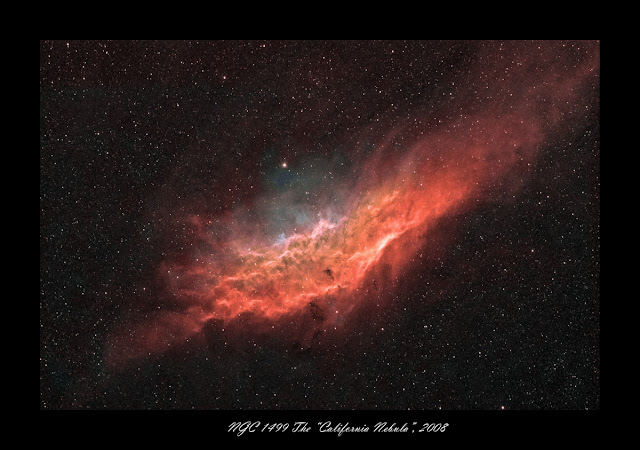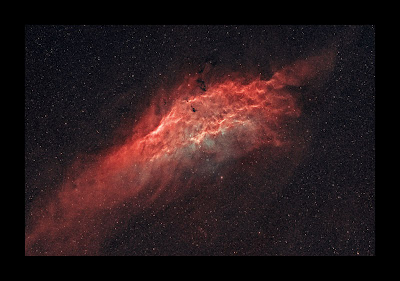COPYRIGHT, PLEASE NOTE
All the material on this website is copyrighted to J-P Metsavainio, if not otherwise stated. Any content on this website may not be reproduced without the author’s permission.
BUY A MUSEUM QUALITY POSTER
BUY A POSTER:https://astroanarchy.zenfolio.com/
Thursday, November 6, 2008
The California Nebula, NGC1499
 S-II, H-a and O-III composition, Hubble palette
S-II, H-a and O-III composition, Hubble palette  H-a+35%S-II, O-III and O-III+30%H-a, "Natural color" composition
H-a+35%S-II, O-III and O-III+30%H-a, "Natural color" composition 
to better show actual nebulosity
-
-
This image looks very different, than images of California Nebula usually do.
There is two reasons.
First is, that this is a three color narrowband image, there is not
too many of them, least I haven't seen one.
Second reason is,
that image is "upside down" compared to usual precentation format.
I did this for a reason, narrowband composition reveals new structures in nebula,
they are very three dimensional and this position shows them best.
-
Imaging data: Camera, QHY8
- Filters, Baader 7nm H-alpha, Baader 8,5nm O-III and Baader 8nm S-II
- Optics, Tokina AT-X 300mm @ f2.8 - Exposures, 5X 1200s H-alpha, 2 X 1200 O-III and 2X1200s S-II + flats and bias
- Guiding, LX200 GPS 12" + PHD-guiding and Lodestar
-

This is how Claifornia Nebula is usually shown.
Subscribe to:
Post Comments (Atom)









2 comments:
Hi, why do you make a switch to the monochrome Qhy9 if you make this wonderfull!! narrow pictures with a colour camera Qhy8? What improvement do you expect to make?
regard Dick
Hi Dick!
QHY8 is a color camera.
The Bayermatrix in the ccd is not a good match with narrowband filters.
Exampl. H-alpha is using only Red pixels, so only 1/4 of resolution of the ccd is used.
In B&W camera, all the pixels are used, hence the reolution is four times higher.
The sensitivity of B&W ccd is higher too.
I still have the QHY8, and I'll use it this winter to shoot broad band color images in a dark place, outside of city lights.
As you can see, both cameras are very suitable and versatile for astroimaging.
Post a Comment